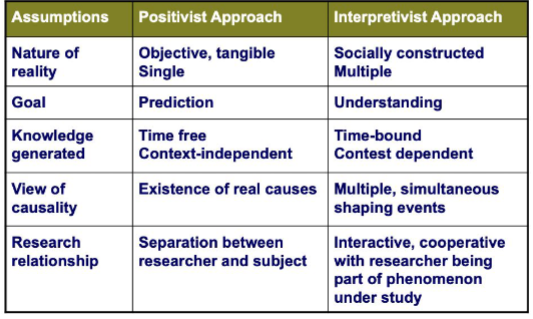Lecture 1 - Buying, Having, Being

This image presents a comparison between two research paradigms: Positivist Approach and Interpretivist Approach, based on different philosophical assumptions. Here’s a breakdown of the table:
Assumptions:
Nature of Reality:
Positivist Approach: Views reality as objective, tangible, and singular, meaning it exists independently of the researcher and can be measured or observed.
Interpretivist Approach: Sees reality as socially constructed and multiple, meaning different individuals may perceive and experience reality in various ways, and there are multiple truths.
Goal:
Positivist Approach: The goal is prediction, aiming to identify general laws and patterns that can predict future behavior or outcomes.
Interpretivist Approach: The goal is understanding, with a focus on comprehending the meaning of human behavior in specific contexts.
Knowledge Generated:
Positivist Approach: Knowledge is seen as time-free and context-independent, implying that findings should be generalizable across time and space, regardless of specific circumstances.
Interpretivist Approach: Knowledge is time-bound and context-dependent, meaning it is shaped by the context in which the research takes place and may not apply universally.
View of Causality:
Positivist Approach: Believes in the existence of real causes that can be identified and measured. The aim is to uncover cause-effect relationships.
Interpretivist Approach: Sees causality as shaped by multiple, simultaneous events, meaning that various factors interact in complex ways to influence outcomes.
Research Relationship:
Positivist Approach: Emphasizes separation between researcher and subject, where the researcher remains detached and objective to avoid bias.
Interpretivist Approach: Involves an interactive, cooperative relationship, with the researcher being part of the phenomenon under study. The researcher collaborates with participants to interpret their perspectives.
Summary:
The Positivist Approach is rooted in objectivity, generalization, and prediction, common in quantitative research.
The Interpretivist Approach values subjectivity, context, and understanding, aligning more with qualitative research.
This table highlights the fundamental differences in how each paradigm views reality, the purpose of research, and the nature of the researcher’s role.
LECTURE NOTES:
consumer - buyer
user - the one who uses it
influencer - influenced consumer
People in the marketplace
consumption communities - ppl we r looking for when buying a product
our choices as consumers relate in powerful ways for the rest of our lives
consumer-brand relationships
self-concept attachment - helps establish user’s identity
nostalgic attachment - serves as a link to consumer’s past
interdependence
love